
Biology of the Prairie Crocus
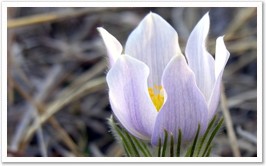 The
prairie crocus (Anemone patens), is the first plant to
bloom on the prairie each year. The true harbinger of spring, its mauve
petals dot the still drab prairie landscape, often before the last winter
have melted. By blooming so early, the crocus assures itself of the complete
attention of available pollinators - small bees and other insects. Its
seeds can then ripen by early June and if moisture is available they will
germinate right away. If the prairie is too dry the seeds will go dormant,
then germinate the following spring. The price for this early flowering
strategy is occasional failure of the seed crop. Severe frosts (-5 to
-10C) during flowering can limit seed production.
The
prairie crocus (Anemone patens), is the first plant to
bloom on the prairie each year. The true harbinger of spring, its mauve
petals dot the still drab prairie landscape, often before the last winter
have melted. By blooming so early, the crocus assures itself of the complete
attention of available pollinators - small bees and other insects. Its
seeds can then ripen by early June and if moisture is available they will
germinate right away. If the prairie is too dry the seeds will go dormant,
then germinate the following spring. The price for this early flowering
strategy is occasional failure of the seed crop. Severe frosts (-5 to
-10C) during flowering can limit seed production.
[Click thumbnail images for larger pictures.]
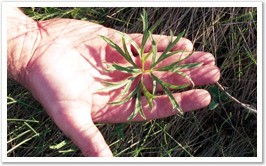 Tufts
of much-divided leaves emerge once flowering is finished and the risk
of severe frost is over, but still well before most other prairie plants.
By mid-July, as the prairie grasses are just reaching their peak of growth,
crocuses begin to die-back and prepare for another harsh prairie winter.
By condensing its life cycle into the spring and early summer the crocus
avoids competition with other prairie plants and avoids the hottest, driest
conditions on the prairies.
Tufts
of much-divided leaves emerge once flowering is finished and the risk
of severe frost is over, but still well before most other prairie plants.
By mid-July, as the prairie grasses are just reaching their peak of growth,
crocuses begin to die-back and prepare for another harsh prairie winter.
By condensing its life cycle into the spring and early summer the crocus
avoids competition with other prairie plants and avoids the hottest, driest
conditions on the prairies.
The crocus is a long-lived perennial with a thick woody taproot. Individual plants may live for 50 years, or more, and a large specimen could be 30 cm across and boast more than 40 blossoms at a time.
Prairie Crocuses are found across a wide region of North america. Here's a map of their distribution: Range Map
Self Planting Seeds
 Crocus seeds are self-planting.
No, really, they are! As a matter of fact, self-planting is a rather common
trick used by prairie plants. Crocus seeds are shaped like spears and
are covered with backward pointing hairs. The long tail is "differentially
hydrophyllic" - meaning it is composed of strands which soak up water
at different rates or to different amounts. The net result is that when
the tail gets wet or dries out, it moves, twisting as the fibers stretch
or contract in relation to each other. The movement, combined with the
backward pointing hairs tends to push the seed head down and through plant
litter and loose soil, effectively "planting" the seed. Or, at least,
getting the seed closer to the soil surface and improving its chances
of germinating. Remember, in a prairie ecosystem there is very little
open soil for seeds, and no one to dig a hole and "plant" them. Most prairie
plants are perennial and regrow each year and the prairie surface is usually
covered with dead, matted plant material, a barrier to seeds reaching
the soil. The self-planting strategy greatly increases the odds of a seed
reaching the soil surface. The strategy is found among a wide range of
prairie plants and reaches its zenith with Porcupine Grass (Stipa spartea).
The seeds of this grass are up to 12 cm long, with the 1.5 cm seed head
tipped with a needle sharp point. (Sounds like a subject for further exploration,
at a later date!)
Crocus seeds are self-planting.
No, really, they are! As a matter of fact, self-planting is a rather common
trick used by prairie plants. Crocus seeds are shaped like spears and
are covered with backward pointing hairs. The long tail is "differentially
hydrophyllic" - meaning it is composed of strands which soak up water
at different rates or to different amounts. The net result is that when
the tail gets wet or dries out, it moves, twisting as the fibers stretch
or contract in relation to each other. The movement, combined with the
backward pointing hairs tends to push the seed head down and through plant
litter and loose soil, effectively "planting" the seed. Or, at least,
getting the seed closer to the soil surface and improving its chances
of germinating. Remember, in a prairie ecosystem there is very little
open soil for seeds, and no one to dig a hole and "plant" them. Most prairie
plants are perennial and regrow each year and the prairie surface is usually
covered with dead, matted plant material, a barrier to seeds reaching
the soil. The self-planting strategy greatly increases the odds of a seed
reaching the soil surface. The strategy is found among a wide range of
prairie plants and reaches its zenith with Porcupine Grass (Stipa spartea).
The seeds of this grass are up to 12 cm long, with the 1.5 cm seed head
tipped with a needle sharp point. (Sounds like a subject for further exploration,
at a later date!)
Solar Heating - Prairie Style
The saucer-shaped construction of many spring flowers like the crocus, is no accident. Neither is the fuzzy centre of the crocus (composed of numerous yellow stamens and a tuft of greyish pistils - that become plumed fruit), nor its highly reflective petals. It all adds up to solar heating . . . Crocus Style!
If you look hard enough there aren't many human innovations that Mother Nature hasn't already figured out! |
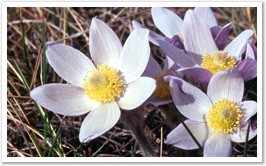 The
sunlight that reaches the crocus' shiny petals is reflected into the flower
centre. This energy is bounced around between the stamens and pistils
warming these vital reproductive parts of the flower. On a sunny day the
temperature inside a crocus flower can be as much as 10 C (18 F) warmer
than the temperature of the surrounding air. Not only does the dish shaped
flower concentrate the sun's warmth, it tracks the sun across the sky,
maximizing the length of time each day that it can stay warmer than the
surrounding air.
The
sunlight that reaches the crocus' shiny petals is reflected into the flower
centre. This energy is bounced around between the stamens and pistils
warming these vital reproductive parts of the flower. On a sunny day the
temperature inside a crocus flower can be as much as 10 C (18 F) warmer
than the temperature of the surrounding air. Not only does the dish shaped
flower concentrate the sun's warmth, it tracks the sun across the sky,
maximizing the length of time each day that it can stay warmer than the
surrounding air.
The warmth at the flower centre aids the development of pollen and seeds, but may also help insects survive and reproduce in the somewhat harsh climate of early spring. So, the next time you see a crocus, take a close look at its yellow centre. The insects you see crawling around may not just be there for a meal. On a cool spring day the centre of a crocus flower is a place to warm up a bit!
Grow Your Own Prairie Crocus
Growing your own prairie crocuses is a rewarding experience, but requires some patience. Crocus seeds are slow to germinate and the plants are slow growing. A crocus may flower at the start of its 3rd growth season, but usually needs 4-5 years before it will put on a good show.
Prairie crocuses grow best in sandy, well-drained soils in sunny locations. Seeds can be collected from wild plants in late June or in early July. Only take a small amount of seeds from any one patch of crocuses to ensure there will be plenty around for natural propagation of the plants. If you don't happen to have a crocus patch nearby, where you can pick your own seeds, you can purchase some from the Living Prairie Museum in Winnipeg (see link below).
Crocus seeds can be planted outdoors right after they are collected, or in autumn, or the following spring. For best results plant the seeds right after they are collected. If the seeds are allowed to dry out for a week or two they will go dormant and will resist germination. If the seeds go dormant they will require stratification (several weeks of exposure to cool moist conditions) before they will germinate. If they are planted outdoors in summer or fall they will experience these conditions naturally over winter. If the seeds are to be planted in the spring after they were collected they should be stratified. Place them in a platic bag with some slightly damp sand, then store the bag in a refrigerator for 4-8 weeks, prior to planting.
To plant crocus seeds outdoors choose a sunny location and prepare the site as follows. The soil should be free of competing plants and, hopefully, free of weed seeds. In a natural area (such as a meadow or prairie), loosen the top layer (1-2 cm) of sod or soil and remove any plants, roots or debris. Sow the crocus seeds onto the top of the soil, covering them with about 1 cm of soil, then pack the soil down firmly with your foot. Water the site well and if possible return to the site to water it on a regular basis if weather conditions are dry. In a garden you can plant the seeds in the same manner.
My garden crocus rewarded me in 1995 with 67 blossoms. It was a football sized mound of mauve petals with bright yellow centers. With patience, anyone can grow a crocus. It takes about 3 years to bloom for the first time and you're lucky to get more than one flower, but after that the number of blossoms increases dramatically. My 67 flowers came on a 6 year old plant grown from seed planted in 1989. In 2009 I still got 25 blossoms on my plant that is now 20 years old! -- Johnny C.-- |
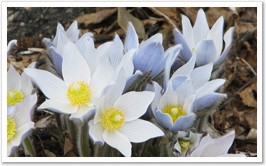 Crocuses can also be started indoors or in a greenhouse prior to planting them
outdoors. This is actually the best way to propagate them as they are
slow to germinate and grow slowly for the first few months. This makes
them subject to competition and crowding from weeds or other plants. Giving
them a headstart indoors will help them to fare better when they are transplanted
to a permanent location. Select a sandy potting soil or add some sand
to regular potting soil. Choose planting trays that have individual cells.
This will enable you to transplant individual plants easily. Fill the
cells with soil and pack it in firmly, then add a few seeds to each cell.
Cover them with 1/2 cm of soil and pack this down firmly as well. Thoroughly
soak the soil in the trays with water and keep them moist until the crocuses
begin to germinate. Be patient, crocuses may take 3-4 weeks to germinate!
After germination allow the top of the soil to dry out between waterings.
When the crocuses have reached the 3-leave stage (that is, the seedlings
will have 3 leaves) thin them out so that there is only 1 per cell. They
can be transplanted to outdoor locations in gardens or fields at the 4-5
leave stage. Water them regularly for a week or two after transplanting.
After this time they should be able to fend for themselves in a garden
or in the wild.
Crocuses can also be started indoors or in a greenhouse prior to planting them
outdoors. This is actually the best way to propagate them as they are
slow to germinate and grow slowly for the first few months. This makes
them subject to competition and crowding from weeds or other plants. Giving
them a headstart indoors will help them to fare better when they are transplanted
to a permanent location. Select a sandy potting soil or add some sand
to regular potting soil. Choose planting trays that have individual cells.
This will enable you to transplant individual plants easily. Fill the
cells with soil and pack it in firmly, then add a few seeds to each cell.
Cover them with 1/2 cm of soil and pack this down firmly as well. Thoroughly
soak the soil in the trays with water and keep them moist until the crocuses
begin to germinate. Be patient, crocuses may take 3-4 weeks to germinate!
After germination allow the top of the soil to dry out between waterings.
When the crocuses have reached the 3-leave stage (that is, the seedlings
will have 3 leaves) thin them out so that there is only 1 per cell. They
can be transplanted to outdoor locations in gardens or fields at the 4-5
leave stage. Water them regularly for a week or two after transplanting.
After this time they should be able to fend for themselves in a garden
or in the wild.
Young crocus plants will spend their first year or two growing an extensive root system, an important adaptation to drought-prone prairie environments. They will usually not flower until their third growing season, but from then on they will reward your patience by blooming faithfully for many years.
If you can't wait that long to see some beautiful crocuses you can download this Crocus Poster to use as computer wallpaper, or print it out for your wall. -- Johnny C. -- |
You can purchase seeds to grow your own Prairie Crocus from Winnipeg's Living Prairie Museum. Or you can buy seedling plants from Prairie Originals or PrairieFlora.
Classification
Here's the official classification of prairie crocus:
Kingdom: |
Plantae |
The Name Game
A prairie crocus by any other name . . .
Could be a . . .
Crocus anemone
Prairie anemone
Pasque flower
Ears of the earth
Wind flower
Blue tulip
Gosling
April fool
These are all common names applied to the same plant, Anemone patens (Pulsatilla patens), in different parts of its North American range. That is why botanists shy away from using common names and refer to plants by their scientific names. The scientific name for our crocus, Anemone patens, is derived from:
Anemo (from Greek) - pertaining to the wind, patens(from Latin) - spreading or outspread.
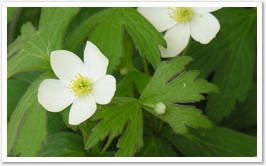 Pulsatilla (from Latin "pulsare") - to beat or pulse, perhaps a reference
to the daily opening and closing of the blooms.
Pulsatilla (from Latin "pulsare") - to beat or pulse, perhaps a reference
to the daily opening and closing of the blooms.
The prairie crocus belongs to the family of plants called the Ranunculaceae (buttercup or crowfoot family). It is, as its scientific name implies, an anemone. It has several close relatives on the prairies, all of which are known as anemones: cut-leaved anemone (Anemone multifida), long-fruited anemone (Anemone cylindrica) and Canada anemone (Anemone canadensis). The term "Crocus" is a misnomer applied by European immigrants to a plant that reminded them of the European crocuses (Crocus spp.), which belong to the Iridaceae (iris family).
The town of Arden, Manitoba, up near Neepawa, is home to lots of real crocuses and real crocus fans! Check out their Crocus Photo Contest at the Arden, Manitoba web site. |
Please carry on for more: Even More Crocus Stuff!
| You can help NatureNorth produce more great articles with a secure donation through PayPal. Our Google Adsense ads pay our server costs, but that's about it. To learn more follow this link: Support NatureNorth. Thank-you! | |
Return to: Spring Issue | NatureNorth Front page
